1. Introduction
 Foxconn is the registered trade name of Hon Hai Precision Industry Co., Ltd., a global designer, manufacturer and distributor of advanced computer, communications, and consumer electronics components, including motherboards, graphics cards, CPU coolers, barebone systems, and chassis for personal computer desktops and servers.
Foxconn is the registered trade name of Hon Hai Precision Industry Co., Ltd., a global designer, manufacturer and distributor of advanced computer, communications, and consumer electronics components, including motherboards, graphics cards, CPU coolers, barebone systems, and chassis for personal computer desktops and servers.
We asked Foxconn to provide us with their latest 775 socket based motherboard for Intel platforms, the 975X7AA-8EK7AA. This motherboard is designed for Intel's Pentium Extreme Edition, Pentium D and future Presler and Cedar Mill processors based on the Intel 975X + ICH7R chipset with 1066/800MHz FSB and Dual Channel DDRII 533/667 support. The 975X7AA-8EK7AA also has two PCIe VGA slots, dual Gigabit Lan and High Definition 7.1 channel audio.

- Features
- Supports Intel® Pentium® processor Extreme Edition, Pentium D and future Presler and Cedar Mill processors
- RoHS Compliant
- Intel® 975X + ICH7R chipset
- Exclusive FOX ONE technology
- 1066/800MHz front side bus
- Dual Channel DDRII 533/667 and more, max 8GB
- 2 x ATA133 + 6 x Serial ATA II
- 2 x PCIex16 (Signaling at x8), 2 x PCIex1, 2 x PCI
- Dual Marvell 8055 Gigabit (10/100/1000) Ethernet (PCIe)
- Realtek ALC882H; 7.1 channel (HDA)
- 8 x USB 2.0
- Redundant BIOS
- 64-bit and Hyper-Threading technology
- Specifications
Processor |
Supports compatible Intel® Socket 775 processors.
Intel® Smithfield, Pentium® D, Pentium® 4, Celeron D Prescott processors, Socket T
(LGA775) |
Chipset |
Intel® 975X Express + ICH7R |
Memory |
Dual channel, unbuffered, 1.8V DDR2-533/667 w/ or w/o ECC; (4) 240-pin DIMM sockets, max 8GB |
Graphics |
Discrete (non-integrated) - use expansion slot |
Expansion Slots |
2 x PCI Express x16 (function as 2 x8 under ATI CrossFire), 2 x PCI Express x1, 2 x PCI |
IDE/ATA Support |
1 x ATA/100 + 4 x SATA II/300 (w/ RAID)
Supports RAID 0, 1, 5, 10, and Intel Matrix Storage Technology (1+0 on 2 HDDs)
Includes second SATA RAID controller, 1 internal + 1 rear panel/external connector (supports RAID 0 and 1) |
Audio |
Integrated, 7.1 channel High Definition (Realtek) |
LAN |
Dual integrated Gigabit Ethernet (10/100/1000) controllers, dual ports (Marvell) |
IEEE-1394 |
2; 1 x 6-pin in rear I/O area + 1 front via internal header; 1394a
Includes cable/brkt for alternate connection - 6-pin or 4-pin from internal header
Max of 2 connections |
USB |
Up to 8; 4 in rear I/O area + 2 internal 2-port headers; ver. 2.0 |
Rear I/O Ports |
1 x PS/2 keyboard
1 x PS/2 mouse
1 x RJ45 (LAN)
4 x USB 2.0
1 x line-in/line-out/mic (audio)
1 x parallel (SPP/ECP/EPP)
Additional line-outs for 7.1 channel audio
Second RJ45 (LAN)
1 x IEEE-1394
2 x S/PDIF (1 x coax out + 1 x optical out) |
Internal Connectors/Headers |
1 x floppy disk drive
Front audio header
2 x USB 2-port headers, ver. 2.0
1 x IEEE-1394 header |
BIOS |
4Mb flash EEPROM w/ LAN boot, PnP, ACPI, WfM, DMI 2.0, |
Special Features |
Wake-on-LAN (WOL), suspend-to-RAM (STR, S3), suspend-to-disk (STD, S4)
FOX ONE, Fox LiveUpdate
RoHS compliant |
Overclocking Features |
Adjustable bus speeds
Adjustable memory timing
Adjustable voltages (may be Vcore only)
Adjustable ratios |
Form Factor |
ATX, 12'' x 9.6'' or smaller - see User's Manual |
Dual PCI-E Graphics Performance
The Intel 975X chipset supports a maximum 8 GB dual-channel DDR2 667/533 architecture, 1066/800 FSB, PCI Express x16 graphics and dual-core CPU. With the 5 x Serial ATA ports routed through the SATA 3 Gb/s RAID controller integrated into the ICH7R Southbridge, the Intel 975X satisfies the raw bandwidth needs of gamers when overclocking both the CPU and memory. The dual PCI-E graphics slots support two 8-lane PCI Express links for fabulous graphics performance for next generation GPUs and games as well as video rendering and other memory intensive applications. With an increasing number PC game developers taking advantage of dual GPU performance, the 975X7AA-8EK7AA is ready for tomorrow’s action.
The “FOX ONE” Advantage
The cutting edge “FOX ONE” central control system is designed exclusively for FOXCONN motherboards with Intel chipsets. It enables the automatic monitoring of a PC's system status, including system frequencies, voltages and temperatures, as well the automatic and intelligent adjustment of major system components. It also gives users the ability to make extensive manual adjustments. FOX ONE Technology enables users to choose between 4 modes: Auto, Power Gaming, Data Mining and Energy Saving. FOX ONE makes it easy for users to tailor their systems to match performance needs, without the risk of damaging the CPU or other components.
The 975X7AA-8EK7AA has a Realtek ALC882H onboard audio codec for HDA and 8-channel (7.1 surround) sound and audio. The board supports eight channel analog outputs along with two digital outputs through optical and RCA S/PDIF connectors. The board supports 8 x USB 2.0 ports. One really useful feature is a rear SATA II external connector that easily extends serial ATA device support without opening the chassis. Faster than USB, it is perfect for an extra SATA HDD or Optical device. The motherboard supports 64-bit and Hyper-Threading technology for the newest Intel processors and software applications. A Dual Marvell 8055 Gigabit (10/100/1000) Ethernet (PCIe) controller provides high performance LAN connectivity. Support for RAID 0, RAID 1, RAID 10, RAID 5 disk management is available as is the new RAIDm1 (Reliable Access In a Disk by mirror1) function that enables RAID 1 functionality in one hard disk, saving the cost of one drive.
The board includes seven super functions that allow users to customize, modify, personalize and backup their motherboard settings. A BIOS backup function is provided provide in case of BIOS boot failure or virus attack.
- Retail Package


The retail package includes:
- The motherboard
- 2 x SATA cables
- 1 x 2-port USB2.0 port module
- 1 x 2-port IEEE1394 port module
- 2 x UltraDMA 133/100/66 cable
- 1 x FDD cable
- 2 x power SATA cables
- 1 x I/O Shield
- User' s manual
- 1 x CD with drivers and utilities


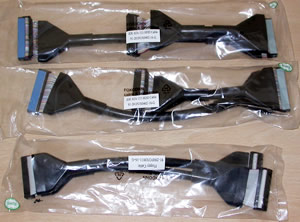
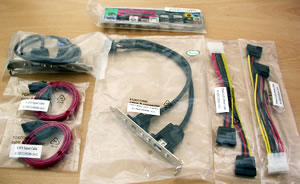
2. A Closer Look
The Foxconn 975X7AA is a well designed motherboard on a red PCB. The connections, PCI and memory slots are all colour coded in order to make it much easier to identify where you should connect cables or install components.

Click to enlarge
Below you can see the 775 socket with the plastic cover, which protects the socket from damage. Don't forget, with 775 processors, the pins are on the socket and not on the processor, so a little caution with the motherboard is necessary.


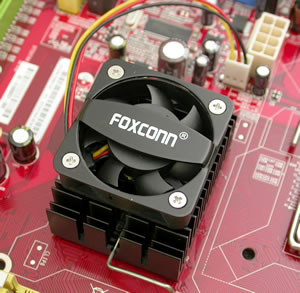

The Northbridge and Southbridge have their own cooling systems. The i975X Northbridge has a fan while the ICH7R Southbridge uses a silent, passive cooler.
The Dual Channel DDR2 slots supports 533/667MHz and 800MHz, with maximum capacity up to 8GB. In order to run a pair of DDR2 modules in dual channel, you have to use two slots of the same colour, that is, either the yellow or the blue.
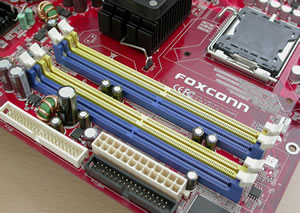
There are only two extra fan connections on board, apart from the one for the CPU and Northbridge. A couple more connections would be welcome, not in the sense that you need to install that many extra fans, but depending on where you install your fan, the cable doesn't always reach so having a connection at each of the four sides of the motherboard helps.
A firewire connection is available on the back panel of the board, however there is an extra socket on the motherboard for more connections.

The CPU power slot can take an 8-pin EPS12V cable or a 4-pin ATX12V cable.
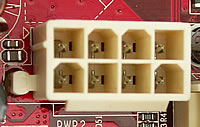
The 24pin power connector is located parallel to the floppy connection.

For extra power, especially in Crossfire mode, you'll have to connect a 4pin power cable to the board.

There is only one IDE connection, the onboard Primary...

...but six SATA connections, as well as one on the back panel.
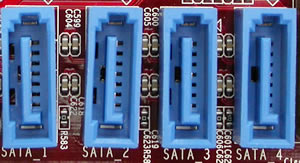
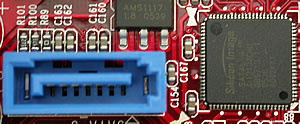
If you need more than the four USB2.0 connections available on the back panel, there are four more.

Dual graphics card slots with Crossfire support.

On the back panel there are the following ports:
1 x PS/2 keyboard
1 x PS/2 mouse
1 x RJ45 (LAN)
4 x USB 2.0
1 x line-in/line-out/mic (audio)
1 x parallel (SPP/ECP/EPP)
Additional line-outs for 7.1 channel audio
Second RJ45 (LAN)
1 x IEEE-1394
2 x S/PDIF (1 x coax out + 1 x optical out)

3. Test System - Configuration
- Processor: Intel Pentium 4 3.73GHz Extreme Edition
- Case: Thermaltake Matrix
- Motherboard: Foxconn 975X7AA, ASUS P5WD2-E Premium
- Graphics Card: ASUS EAX1600XT Silent
- Memory: OCZ PC2-5400 Platinum XTC Dual Channel 2x512MB
- Hard Disk Drive: WD800JD 80GB 7200RPM
- DVD Burner: Samsung SH-W163
- Power Supply: Thermaltake PurePower 520W
- OS: Microsoft WindowsXP Pro SP2
- DirectX: v9.0c
- ATI Catalyst 6.4

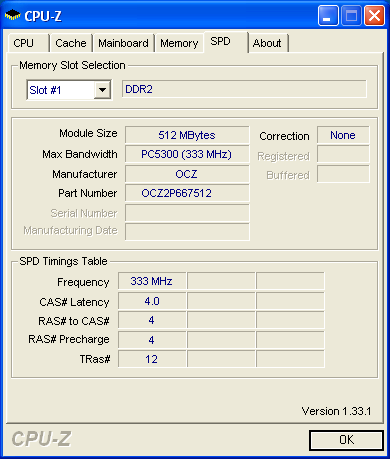
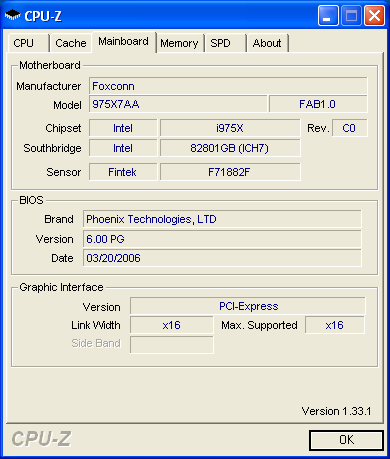
Benchmarking Software
3DMark05,03,01
PCMark04, 05
Codecreatures Benchmark Pro
Performance Test V5.0
Half Life 2
Quake 4
F.E.A.R.
Need For Speed - Most Wanted
In this review, we will be testing the performance of the Foxconn 975X7AA. For comparison, we will also post the results of the ASUS P5WD2-E Premium. Both boards are based on the same chipset, the Intel 975X.
4. 3DMark2005
 With 3DMark05, Futuremark continues its tradition in benchmarking software by providing a state-of-the-art Microsoft ® DirectX ® 9 3D performance benchmark.
With 3DMark05, Futuremark continues its tradition in benchmarking software by providing a state-of-the-art Microsoft ® DirectX ® 9 3D performance benchmark.
3DMark05 is an all new 3DMark version making the most of Microsoft's DirectX
9. The previous version 3DMark03, did a nice introduction into this level
of technology. However
3DMark03 used DirectX 9 specific features in a limited manner, because fully
supporting hardware was rare at the time of its launch. In contrast, 3DMark05
requires DirectX 9 hardware with full support for at least Shader Model 2,
and takes shader usage to never before seen levels.
Just like its predecessors, 3DMark05's point system is set so that at the
moment of release, the high-end VGA cards available in stores can only score
around 5000 3DMarks, whereas the worst card that meets the programs requirements
yields a score of 1000.
Game Test 1 -Return to Proxycon
 Being the sequel to the "Battle of Proxycon"
from 3DMark03, in "Return to Proxycon" we're once again set in space
and the battle continues as space pirates invade a cargo ship in order to
take control of its valuable cargo.
Being the sequel to the "Battle of Proxycon"
from 3DMark03, in "Return to Proxycon" we're once again set in space
and the battle continues as space pirates invade a cargo ship in order to
take control of its valuable cargo.
This test, tries to simulate a future first-person shooter game with all the high details that entails. The dynamic shadows, high-detailed environment and advanced lighting techniques ensure that under normal circumstances, no recent card can run it with decent frame rates.
Game Test 2 - Firefly Forest
 A forest gets filled with magic fireflies in the night. The moon is nearly full, illuminating the forest with a bluish faint light. The magic fireflies have flickering bright green lights that playfully move around the forest.
A forest gets filled with magic fireflies in the night. The moon is nearly full, illuminating the forest with a bluish faint light. The magic fireflies have flickering bright green lights that playfully move around the forest.
This scene is a nice example of a smaller scale outdoor scene with rich vegetation. Immediate visibility is not so far, and there is a skybox surrounding the whole scene.
A large number of trees with their branches swinging separately, and dense vegetation being dynamically distributed according to the camera movements, make this test the most demanding of the three.
Game Test 3 - Canyon Flight
 A Jules Verne type airship flies through a canyon guarded
by a dangerous sea monster. The airmen defend their ship using heavy cannons,
but these seem to have no effect on the huge sea monster. Finally the crew
manages a narrow escape using the "last resort" afterburners of
the airship.
A Jules Verne type airship flies through a canyon guarded
by a dangerous sea monster. The airmen defend their ship using heavy cannons,
but these seem to have no effect on the huge sea monster. Finally the crew
manages a narrow escape using the "last resort" afterburners of
the airship.
This scene is fairly complex with large areas of water
reflecting the high canyon walls. The water actually is one of the key points
of interest in this scene. The water not only does realistic looking reflections
and refractions, it has a depth fog, making the sea monster swimming under
the airship actually look deep down in the water. The air in this scene also
uses a volumetric fog, making distant cliffs of the canyon really look far
away.

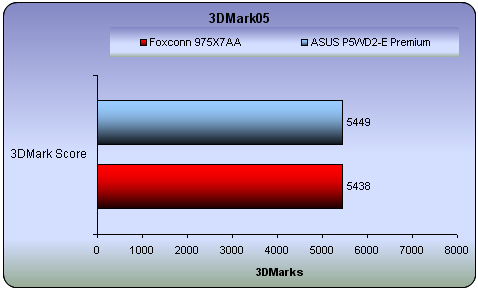
There is negligible difference in the 3dMark05 scores for both motherboards, and the overall performance of both is identical. The average framerates in the 3DMark benchmark games are the same.
5. 3DMark2003
 3D Mark is a widely used and accepted benchmark that stresses the DirectX performance of a VGA card. A very strong point of 3DMark is that it's VGA card measuring is does not require any CPU power. So the resulting fps are a good reference a VGA card's rendering performance. For testing the performance of each card we used the 4 game benchmarks 3DMark has.
3D Mark is a widely used and accepted benchmark that stresses the DirectX performance of a VGA card. A very strong point of 3DMark is that it's VGA card measuring is does not require any CPU power. So the resulting fps are a good reference a VGA card's rendering performance. For testing the performance of each card we used the 4 game benchmarks 3DMark has.
3Dmark03 also includes sound and CPU tests as well as some other feature tests.
If you test your machine with 3DMark, you can post the results at 3DMark's online result browser. For more information, visit futuremark.com.
- Game Test 1 - Wings of Fury (DX7)

This test is a combat flight simulator written for older hardware (DirectX 7). Particles are used a lot in this test - smoke and vapor trails, flak and gunfire, and explosions are produced using point sprites and quads.
- Game Test 2 - Battle of Proxycon (DX8)

This test is a simulation of first person shooter game types. 1.1 and 1.4 Vertex shaders are widely used since all character models are skinned using vertex shaders.This makes this test a good vertex shader comparison for VGA cards.
- Game Test 3 - Trolls' Lair (DX8)

This test should be the favorite of all RPG lovers. It is a cut scene of a female warrior facing two malicious trolls. Again the same vertex and pixel processing is used as in game test 2.
This test also uses post-processing effects, such as Depth of Field and Bloom effects which are widely used in today's game cut scene sequences.
- Game Test 4 - Mother Nature (DX9)

Mother nature represents the level of effects and realism that are possible using 2.0 vertex and pixel shaders, plus some other features that DirectX 9 offers.
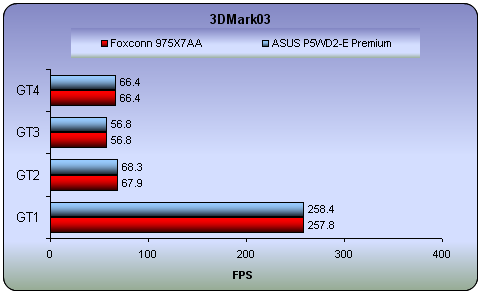
Once again, quite close results between the two motherboards. The difference of 17 3DMarks is not enough to distinguish one board as being better than the other.

6. Codecreatures
 CodeCreatures is a synthetic 3D benchmark that is a good reference for VGA performance comparison. This is a high-end 3D benchmark that also requires DirectX 8 hardware, making a good tool for measuring the potential of DirectX 8 game performance.
CodeCreatures is a synthetic 3D benchmark that is a good reference for VGA performance comparison. This is a high-end 3D benchmark that also requires DirectX 8 hardware, making a good tool for measuring the potential of DirectX 8 game performance.
The Codecreatures benchmark is written with Microsoft's DirectX 8.1 API and incorporates the use of Vertex and PixelShaders popular on next generation 3D accelerators.

The benchmark plays a photo-realistic nature scene and calculates the performance of the graphics adapter by measuring the fps that it can display at 1024x768, 1280x1024 and 1600x1200 resolutions.
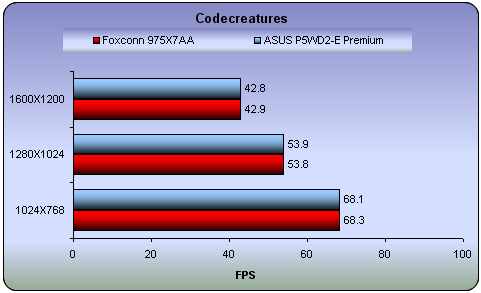
No actual difference between the two motherboards, almost the same framerates and overall score.
-Codecreatures number
The codecreatures number is the resulting score of the total
benchmarking process and is basically the geometric mean of the three frame
rates multiplied by 100.
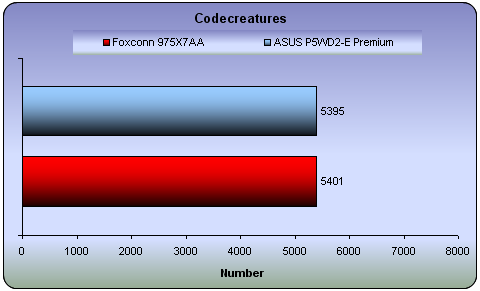
7. Aquamark - 3DMark01
 Since the majority of today's applications and games are compatible with DirectX 9, the need of benchmark applications that use DX 9 has been brought up. The benchmark uses the 3D engine (Krass engine) of the Aquanox game.
Since the majority of today's applications and games are compatible with DirectX 9, the need of benchmark applications that use DX 9 has been brought up. The benchmark uses the 3D engine (Krass engine) of the Aquanox game.
Aquamark Triscore
The Aquamark Triscore comprises 3 values: the overall system performance, the performance of the graphics system and the CPU performance. Keep in mind that this is not the total result of the tests, but the result of the whole benchmark process including all 9 chapters.
Unfortunately, we couldn't run the Aquamark 3 benchmark. The program either ended with an error or the PC froze with a 'black screen'.
3DMark2001 Score
3DMark 2001 is the predecessor to 3DMark03. It's mainly a directx8.1 benchmark and the score depends a lot on the CPU power of your computer. However for reference use only we decided it'd be best to just leave it in our benchmark list so you can compare the next generation cards with the possibly outdated you have at home.
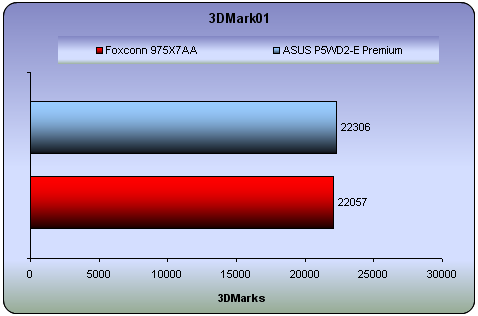
The 3DMark score is higher for the ASUS motherboard but the difference is not that great.
8. Half Life 2
Half life 2 is no doubt the most anticipated pc game of all times.
 Characters - Advanced facial animation system delivers the most sophisticated in-game characters ever seen. With 40 distinct facial "muscles," human characters convey the full array of human emotion, and respond to the player with fluidity and intelligence.
Characters - Advanced facial animation system delivers the most sophisticated in-game characters ever seen. With 40 distinct facial "muscles," human characters convey the full array of human emotion, and respond to the player with fluidity and intelligence.
Physics - From pebbles to water to 2-ton trucks respond as expected, as they obey the laws of mass, friction, gravity, and buoyancy.
 Graphics
- Source's shader-based renderer, like the one used at Pixar to create movies
such as Toy Story® and Monster's, Inc.®, creates the most beautiful
and realistic environments ever seen in a video game.
Graphics
- Source's shader-based renderer, like the one used at Pixar to create movies
such as Toy Story® and Monster's, Inc.®, creates the most beautiful
and realistic environments ever seen in a video game.
AI - Neither friends nor enemies charge blindly into the fray. They can assess threats, navigate tricky terrain, and fashion weapons from whatever is at hand.
To measure performance we used the Video Stress Test(VST) that is available in the CounterStrike:Source beta available through Steam. We set all the details to the highest level and each time changed the resolution from 800x600 up to 1600x1200.
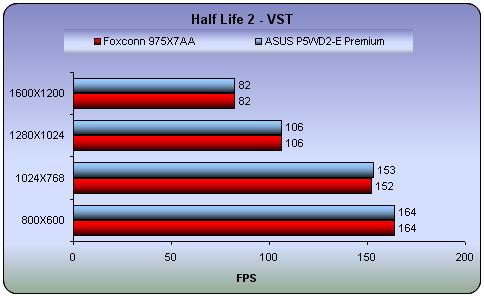

The game more closely approaches reality, and for many people it is the the measure by which all other games are judged. In Half Life 2 both motherboards performed similarly, while the framerates are more or less the same.
9. Doom 3

A massive demonic invasion has overwhelmed the Union Aerospace Corporations’ (UAC) Mars Research Facility leaving only chaos and horror in its wake. As one of the few survivors, you struggle with shock and fear as you fight your way to Hell and back, in an epic clash against pure evil.
Activision made it's miracle again with Doom 3 which is said to be the best-looking game ever, thanks to the brand-new OpenGL graphics engine used to generate its convincingly lifelike, densely atmospheric, and surprisingly expansive environments. If you are a fan of the previous Doom games then you will get many flashbacks with this revision, since you will find re-imagined versions of almost every monster from both Doom and Doom II.

To measure performance on the game we used the timedemo demo1 command from the console (Alt+Ctrl+~).
Enabling the high quality setting and executing the timedemo demo1 command twice for each resolution, we witnessed the following:
First, without the Anti-Aliasing and Anisotropic Filtering settings
enabled, we got the following results:
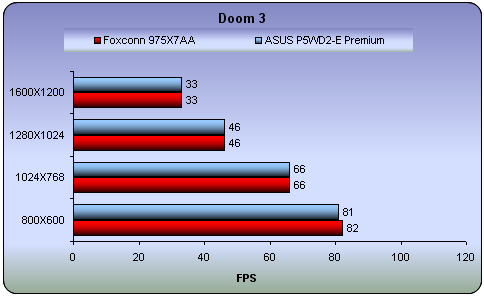
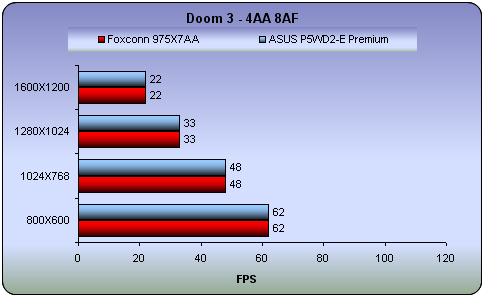
It seems that the scene is again the same here. Both boards reported the same framerates, this time with Doom 3.
10. F.E.A.R.
 You aren't a soldier. You are a weapon. A paramilitary force infiltrates a multi billion dollar aerospace compound taking hostages, but issuing no demands.
You aren't a soldier. You are a weapon. A paramilitary force infiltrates a multi billion dollar aerospace compound taking hostages, but issuing no demands.
The government responds by sending in its best special operations teams, only to have them obliterated. Live footage of the massacre is cut short by an unexpected wave of destruction that leaves military leaders stunned and in disbelief.
First Encounter Assault Recon (F.E.A.R.) is one of the new-generation FPS. The graphics are really stunning, the plot behind the whole shooting successfully keeps it interesting and even the A.I. seems to work out well.
F.E.A.R. offers a lot to the First Person Shooter world. The graphics are very clear with excellent textures, great new effects that will stress your graphics card and ragdoll physics that are waiting to be exploited as you progress through the game.
- Benchmark Settings
F.E.A.R. allows you test the video settings on a mini-benchmark involving a lot of weapon firing, explosions and several other effects. After the benchmark is run, you're presented with a screen showing your minimum, average and maximum framerates and also percentages of how often the framerate was below 25fps, between 25 and 40, and finally above 40. For this presentation, we're just sticking to the minimum and average framerates.

The resolutions we used were 800x600, 1024x768, 1280x960 and 1600x1200. We measured performance with high and highest details.

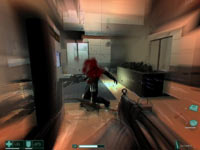
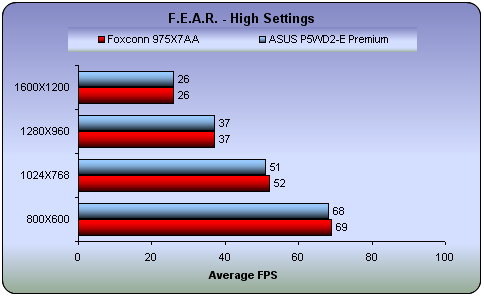
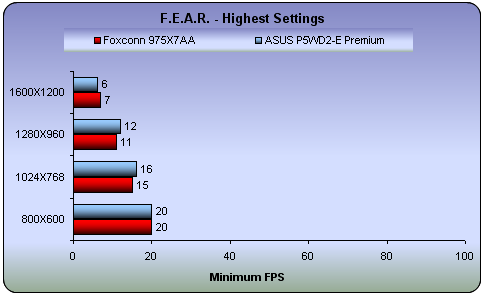
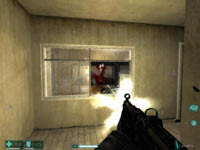
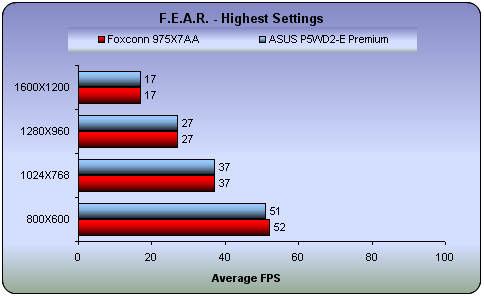
F.E.A.R. is a rather demanding game and it is a good indicator of performance. Once again, both the ASUS and Foxconn motherboards provided almost identical performance.
11. Need For Speed - Most Wanted
 Wake up to the smell of burnt asphalt as the thrill of illicit street racing permeates the air.
Wake up to the smell of burnt asphalt as the thrill of illicit street racing permeates the air.
Combining illicit street racing and tuner customization with the intensity of strategic police pursuit that surpasses any Hollywood-style chase scene, Need for Speed Most Wanted will be on every gamer's 'must-have' list this holiday season. Out-race rivals, evade cops and exploit hundreds of miles of open road as gamers make their way up the Blacklist.
To become the most wanted racer, players must build up their street cred and Rap Sheet with gripping, white knuckle, head-to-head races with the top drivers on the streets, as well as pull daring, evasive moves to out-run and out-fox the cops that patrol the open road. Players can manage their heat or utilize a number of strategic tactics to keep the cops off their tails as they leave their rivals behind to suck their exhaust fumes.

- Benchmark Settings
NFS Most Wanted includes no default benchmark. To measure the card's performance, we've chosen to record the framerate at the start of a circuit race with end-game cars. The starting point tends to be one of the most graphically demanding parts because of the smoke coming from spinning wheels added to the rest of the game's visual effects. If a card can pass this step with an acceptable framerate, it is guaranteed that it will face no problems with the rest of the game.

The resolutions we used are 800x600, 1024x768, 1280x1024 and 1600x1200. We measured performance at the lowest and highest possible settings.

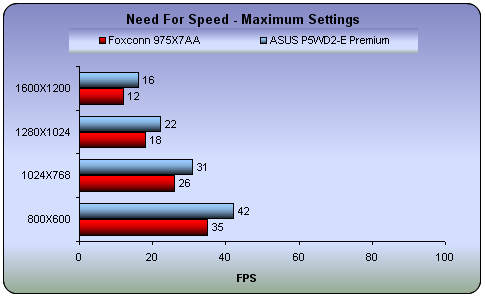
This is the only game benchmark where the ASUS produced a discernable difference in framerate. At all resolutions, there is a small advantage with the ASUS motherboard.

12. Performance Test v5.0
The suite of the PassMark Performance Test contains a number of suites with different tests to measure different aspects of a computer system.
The "PassMark rating" is a weighted average of all the other test results and gives a single overall indication of the computers performance. The bigger the number, the faster the computer. The "PassMark rating" can only be calculated if the results from all other tests are available. The value is calculated as follows.
| Test Suite |
Weighting |
| Disk |
20% |
| CD / DVD |
9% |
| Memory |
18% |
| 3D Graphics |
12% |
| 2D Graphics |
14% |
| CPU |
27% |
| Total |
100% |

The Foxconn was awarded a higher score in the Passmark Performance Test, but the difference is too small to consider one card better than the other.
13. PCMark04 - 05
PCMark04 and 05 are application-based benchmarks and a premium tool for measuring overall PC performance. It uses portions of real applications instead of including very large applications or using specifically created code. This allows PCMark05 to be a smaller installation as well as to report very accurate results. As far as possible, PCMark05 uses public domain applications whose source code can be freely examined by any user.

Both PCMark04 and PCMark05 include 5 categorized suites for benchmarking your computer. These include System, CPU, Graphics, Memory and a Hard Disk Drive benchmark. In our case, we selected the system test suite which integrates tests included in the other categories.

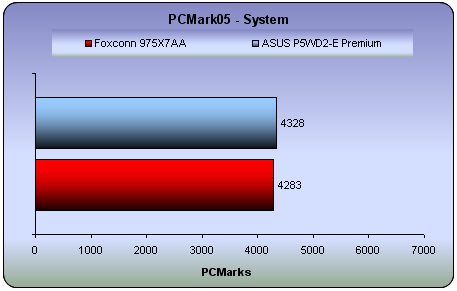
Slightly better performance from the ASUS motherboard in both the PCM04 and PCM05 benchmarks. Here, it would be a good opportunity to take a closer look at the PCM05 tests more analytically, to see where the differences lie:
| Test |
Foxconn |
ASUS |
|
| HDD - XP Startup |
8.133 |
7.959 |
MB/s |
| Physics and 3D |
146.708 |
155.700 |
fps |
| 2D - Transparent Windows |
573.600 |
574.976 |
windows/sec |
| 3D - Pixel Shader |
119.193 |
119.245 |
fps |
| Web Page Rendering |
3.268 |
3.391 |
pages/sec |
| File Decryption |
82.074 |
82.254 |
MB/s |
| 2D - Graphics Memory - 64 lines |
1460.481 |
1461.313 |
fps |
| HDD - General Usage |
4.908 |
4.771 |
MB/s |
| Multithread Test 1 |
| Audio Compression |
1405.124 |
1385.443 |
KB/s |
| Video Encoding |
221.406 |
231.546 |
KB/s |
| Multithread Test 2 |
| Text Edit |
77.944 |
78.355 |
pages/sec |
| Image Decompression |
17.866 |
17.785 |
MPixels/sec |
| Multithread Test 3 |
| File Compression |
3.546 |
3.695 |
MB/s |
| File Encryption |
20.880 |
21.011 |
MB/s |
| HDD - Virus Scan |
26.410 |
26.865 |
MB/s |
| Memory Latency - Random 16 MB |
8.947 |
9.141 |
MAccesses/sec |
In just about all the tests, it's almost an even split between the two motherboards. Only in the 3rd Multithreading Test does the ASUS motherboard outperform the Foxconn outright.
14. Software CD - Fox LiveUpdate
The accompanying CD includes the μGuru Utility, a helpful application for overclocking your system, as well as monitoring the temperature and voltages directly from Windows.
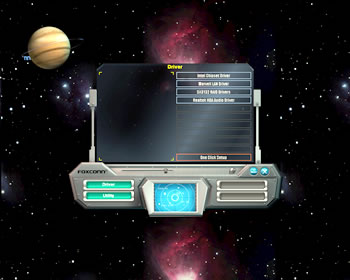
Click to enlarge

Click to enlarge
- Fox LiveUpdate Utility
The Foxconn Fox LiveUpdate is a useful application which will help you update the BIOS on your Foxconn motherboard, as well as find details about the current BIOS version or save it to a file.
We ran Fox LiveUpdate and the first thing we saw was the following screen, informing us about the current BIOS version.

First, we tried to backup the current BIOS version to a file, something you'll be asked automatically before the program updates the BIOS to a newer version.


You can also configure Fox LiveUpdate.


Fox LiveUpdate allows you to change its colors, choosing between three different preset profiles.

At the time we received the 975X7AA-8EK7AA, there was already a new BIOS version available. So we decided to update our board.





The new BIOS

15. FOX ONE
The FOX ONE central control system is designed exclusively for FOXCONN motherboards with Intel chipsets. It enables the automatic monitoring of a PC's system status, including system frequencies, voltages and temperatures, as well the automatic and intelligent adjustment of major system components. It also gives users the ability to make extensive manual adjustments. FOX ONE Technology enables users to choose between 4 modes: Auto, Power Gaming, Data Mining and Energy Saving. FOX ONE makes it easy for users to tailor their systems to match performance needs, without the risk of damaging the CPU or other components.
FOX ONE provides you with all the relevant information, regarding your motherboard's state, while working.

You can manually increase the speed of you processor by increasing the FSB. Alternatively, there are four preset modes, Power Gaming, Data Mining, Office and Energy Saving.

There is also an option to set the speed of your DDR2 memory. Note, that adjusting the FSB automatically changes the DRAM frequency and vice versa.


You can manually increase the voltage of your CPU, DRAM and NB for higher stability.

The rotation speed of the CPU's cooling system fan is also something you can adjust.


16. Bios - Page 1
Below you can see snapshots from the BIOS screens.


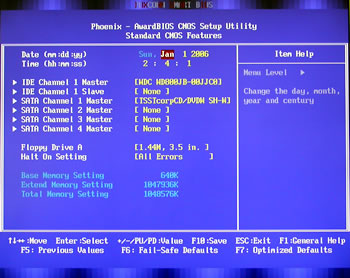


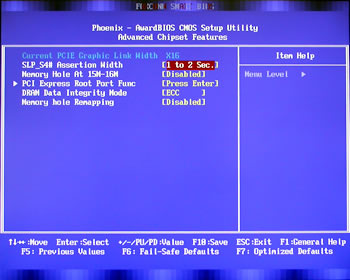
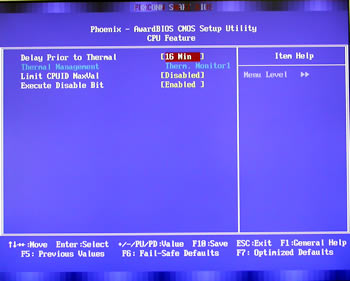
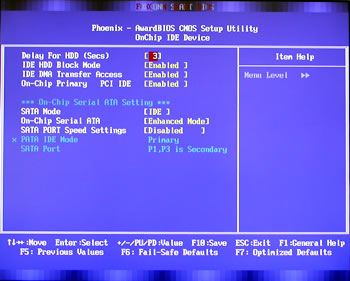
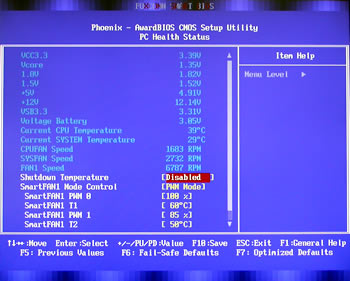
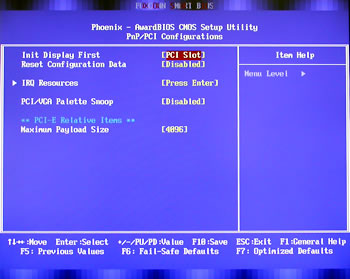
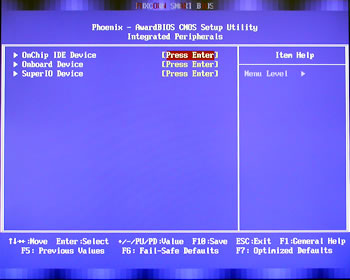

17. Bios - Page 2
In order to overclock the Foxconn 975X7AA-8EK7AA, there are advanced options in the BIOS.

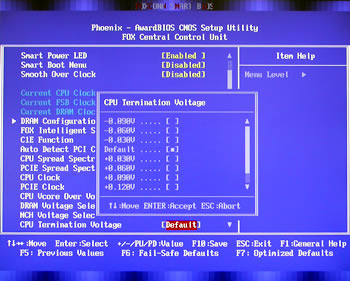
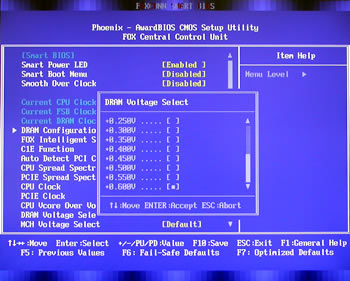
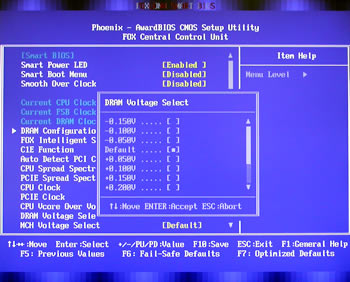



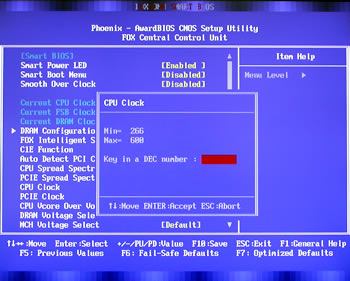
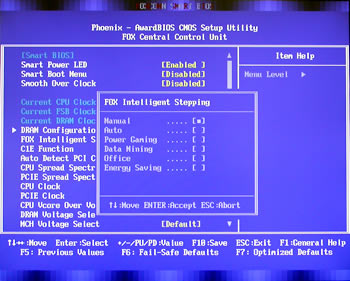
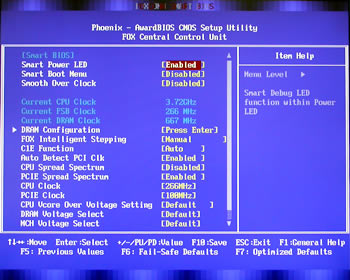
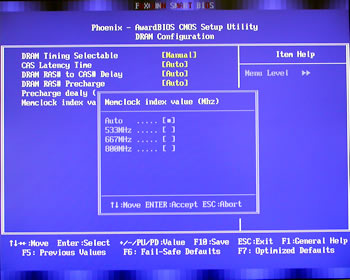
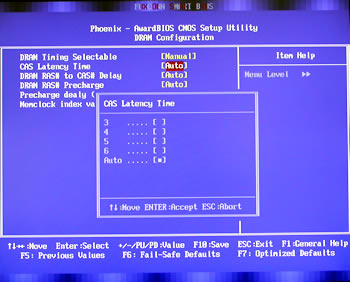
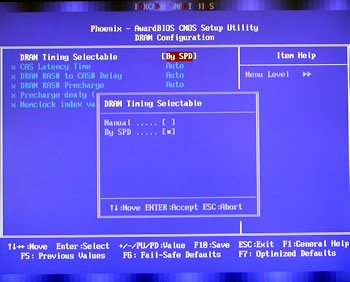
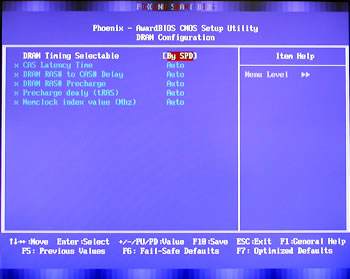
18. Overclocking
The FOX ONE utility is a convenient application to help overclock your system. There is no need to enter into the BIOS with this utility, although we still think the BIOS is the safest way to go.
We manually increase the FSB and set the speed of our Intel P4 3.73GHz Extreme Edition up to 4.26GHz with just a few clicks.

The DRAM frequency, as previously mentioned, was automatically adjusted.

We increased the voltage for the CPU and Memory... and that's it.


The changes were made without having to restart our system.

We checked the stability of our overclocked system using PCMark2005 and 3DMark2005. Both tests finished successfully.
19. Conclusion
The Foxconn 975X7AA is a full specs motherboard with dual PCI-Express, Gigabit LAN, HD-AUDIO, SATA II /IDE RAID, Dual Channel which are only some of the board's long list of features. The board comes in a good retail package that contains almost everything.
The construction of the board is good, while its components comprise the Marvell, Silicon Image and Realtek chipsets, which you'll find on all expensive motherboards. Nothing to complain about other than an indicator led that informs you that the motherboard is powered up and everything is ok would be handy. Most motherboards nowadays include some type of visual indication that the board is operating properly at startup.
As far as overall performance is concerned, it is good. It gained high scores in all our benchmarks and with quite good framerates in our games benchmarks. In our typical comparison with the ASUS socket 775 flagship, the P5WD2-E Premium, the Foxconn 975X7AA produced similar results which in many cases were identical.

The overclocking capabilities of the Foxconn 975X7AA are very good and there are preset profiles to help inexperienced users. Moreover, don't forget the FOX ONE application which can help you tune your motherboard directly from the OS without requiring restarts of the OS.
The price at the time of this review was US$210 from newegg.com. If we consider that overall performance of the Foxconn motherboard compared to the ASUS, was almost identical, then the Foxconn 975X7AA is a good buy since the ASUS motherboard sells for around US$250.
Pros:
- Crossfire support
- Good Retail Package
- Good performance
- Monitor utility, from within Windows
- Very good motherboard overclocking capabilities
Cons:
- No Wireless Lan
- No activity led onboard
